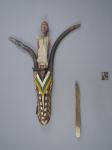sogoba (Rod Puppet)
About this object
History of use
A mobile stage is covered with cloths, concealing the men inside, who move the stage across the dance area. Fitted in front with a wooden animal head (an antelope or buffalo mask), the stage itself is a large puppet. The performances are organized by the village youth organizations, kamalen ton. Sogobò is organized into a series of up to twenty discrete performances separated by short intervals of song and dance. Puppet ensembles include balanin fola (small rod puppets), merekun (large rod puppets), Yayoroba (beautiful women), and maani (smaller figurative forms). The puppet heads or figures poke out from the top of the cloth frame, and are made to twirl and dance as they tower above the stage. The puppets and masks depict animals, fantastic creatures, hunters and characters from village life. Short performances focus on themes of family and village rivalry, jealously and unity, as well as masculine values and their identification with hunters. Bamana farmers and Bozo fishermen participate together in these performances now, but the oral tradition suggests puppet theater originated with the Bozo.
Narrative
Tchuemegne purchased these 20th century Sogobò puppets, textiles and frames (3420/79-100) from Mr. Amadou Fantasa, an elder from the village of Markala in central Mali, in 2019. Fantasa recalled that the puppets had been used in the biannual festivals marking the beginning of the rainy season (June), and related agricultural and fishing activities, and at the start of the dry season (Oct) to signal the coming of the grain harvest. He said the puppets had been in use from 2012-2016, but after that they were in storage. The "coming forth of the masks and puppets in Markala", frequently refered to as "Marakala Sogobò" or "Dobò", is now inscibed on UNESCO's List of Intangible Cultural Heritage.
Physical description
Large antelope puppet head (part a) with detached horn (part b), and a separate manipulation stick (part c). The face of the animal is painted in a plaid pattern of red, white, green and yellow squares with concentric V's on the forehead - red, black, white, green and yellow, and a white heart-shaped nose. The horns are both broken, with one detached. In between the horns is a small human figure with bright pink skin, wearing a beige tunic. The figure's arms are jointed at the shoulders, and are controlled by blue string. The manipulation stick is inserted into a rectangular hole at the back of the head.

Date Made
Before 2000
Date Acquired
5 Feb 2020
How Acquired
Sold
Credit Line
Purchase funded by the Michael O'Brian Family FoundationMore...
Measurements
Overall: 111 cm x 56 cm x 17 cm
Object Number
3420/81 a-c